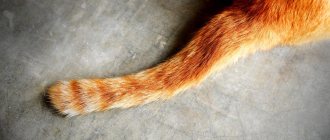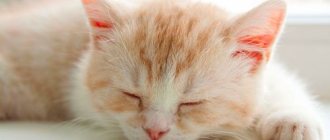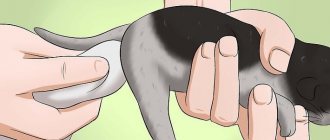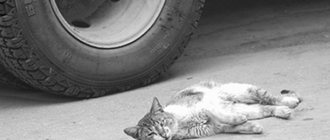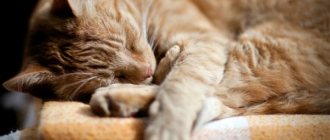11965Administration
Cats are highly mobile, especially when young; when, while playing, they can perform complex tricks, which often end in injury in an apartment. Sometimes even the dog, with whom the cat is friends, can accidentally inflict minor damage during play. A fall from a height usually causes concussions, fractures and bruises of varying severity. If the cat has free access to the street, the risk of injury increases. In such a situation, the owner can easily face the fact that the cat’s paw is bruised. This phenomenon does not pose a danger, but requires proper treatment so that the inflammatory process does not begin. It is also important for owners of four-legged pets to be able to distinguish a simple bruise from more serious injuries, such as fractures and dislocations that require the intervention of a veterinarian.
Causes of dislocation
The reasons why a cat can get dislocated are divided:
- For traumatic or acquired
- To congenital.
Congenital dislocations in cats occur due to abnormal joint structure or impaired mobility, which is called dysplasia. Such pathologies make themselves felt at the age of 6 months and older.
Reference! Persian, Himalayan and Maine Coon breeds are genetically predisposed to congenital joint pathologies.
Sometimes the cause of a dislocation lies in a chronic disease that the cat has, during which joint and bone tissue is destroyed. These diseases include rickets, osteoporosis and osteomalacia.
A cat may twist its paw or dislocate its tail if it makes an unsuccessful jump or falls from a height. Colliding with an obstacle at high speed, car injuries, or cruel treatment of a cat often leads to dislocation of a healthy joint.
An animal can get injured in its front and hind legs while playing with a small child. Such dislocations are most often diagnosed in small kittens whose legs are roughly pulled.
Fights with relatives or other animals can also cause a traumatic dislocation.
Infectious causes of lameness in cats
Lameness on the front paw is a characteristic symptom of calicivirus, a viral disease that affects unvaccinated cats. Pets 2-24 months of age can get sick.
Additional symptoms:
- refusal to eat;
- ulcers and stench from the mouth;
- cough;
- runny nose;
- conjunctivitis.
Lameness occurs suddenly and disappears spontaneously. Another cause of infectious origin is fungal diseases that affect the claws. The horny formations become fragile, break, and it hurts the cat to walk.
What types of dislocations exist in cats?
With any type of dislocation, the cat experiences severe pain.
Depending on the time when the cat received the dislocation, injuries vary:
- fresh or recent, which were received less than 3 days ago;
- not fresh – the dislocation occurred about 2 weeks ago;
- neglected - the animal was injured more than 3 weeks ago.
Dislocation in a cat can be complete or incomplete:
- In case of complete dislocation, the ends of the bones forming the joint do not touch each other; in case of incomplete dislocation, they do.
- Incomplete dislocation is also called subluxation.
Dislocation can be simple, when the soft tissues and skin remain intact, or complex. A complex dislocation is accompanied by rupture of ligaments and tendons, and fractures inside the joints.
Treatment of dogs and cats should be prompt.
After neuroleptanalgesia or local conduction, anesthesia of the peroneal and tibial nerves, a lateral skin incision is made at the site of the tendon rupture (with a closed rupture), blood clots and tendon fragments are removed, and in the position of maximum extension of the tarsal joint, the torn ends are sewn together with a special tendon suture made of durable nylon or lavsan . In case of a wound rupture, the wound along the upper and lower ends of the torn tendon is lengthened to the required length, and then the tendon is sutured in the same way. The skin wound is closed with a knotted suture. The operation is completed with immobilization in a plaster cast.
Tags: Tendon diseases, Surgical diseases
A cat's bruise is one of the types of mechanical injuries. As a result of a violation of the integrity of the lymphatic and blood vessels, hemorrhage occurs.
Symptoms of a dislocation in a cat - how to recognize
A dislocation is the displacement of bones relative to each other without damaging them. By shifting from their anatomical position, bones can damage soft tissue, adjacent tendons, blood vessels and ligaments.
A dislocated limb looks unnatural.
You can recognize a dislocation in a pet by the following symptoms:
- with a congenital dislocation, the animal is lame on one leg;
- with a traumatic dislocation, the cat cannot fully lean on the surface;
- The pet experiences pain from touching the damaged area;
- Not only the gait changes, but also the behavior of the animal: sleep becomes restless, the cat tries to lick the site of the dislocation;
- The dislocated part of the body is usually asymmetrical. A dislocation may be indicated by its unnatural position, the protruding part of the displaced bone;
- With a complex dislocation, ruptures and hematomas are observed in the damaged area.
How to identify a hip dislocation
The hip joint in a cat is quite simple, but despite this, it is the strongest and most mobile. Dislocation of the hip joint (dislocation of the femoral head) is a relative displacement of the femur relative to the pelvis, accompanied by rupture of the round ligament and overstretching of the joint capsule.
An animal that has damaged the hip joint cannot step on the affected limb, which, as a rule, becomes shortened.
Attention! Dislocation of the femoral head is one of the most severe.
Dislocation of the front or back paw
Habitual dislocation causes a lot of inconvenience to the animal.
A dislocation of the front paw in an animal has a similar clinical picture to a dislocation of the hip joint. The cat cannot lean on the affected limb. A dislocated hind or front paw looks asymmetrical, and there is swelling at the site of the dislocation.
Tail dislocation
The tail gives the cat grace, serves as a kind of balancing device and is an extension of the spine. A cat can dislocate its tail in a fight or when hit by a car. Even the most caring owner can accidentally injure a cat by stepping on its tail or pinching it in a door. Externally, a dislocated tail appears crooked. His mobility decreases, the cat experiences pain.
What should you do if your cat is limping on his front leg?
The obvious cause of lameness is injury to a pet's paw. A cat can protect a limb for the following reasons:
- Splinter in the paw pad.
- Injury.
- Sprain.
- Damage to claws.
It is important to try to recall in memory all the events preceding the onset of lameness. If the cat fought with other animals or fell from a great height, the paw hurts due to a bruise or sprain.
A splinter caught in the foot pad can cause severe discomfort. In this case, the cat cannot remove a small foreign body on its own. Since acute pain is felt when putting pressure on the damaged paw, the animal begins to protect it, which is why lameness appears.
The cat does not step on its front paw due to damaged claws. This can also happen if you fall from a great height or get hit. In addition, if someone accidentally steps on a cat's paw, the claw may be broken, which causes the animal a lot of discomfort.
Reasons why a cat is limping
There are many reasons why a cat does not step on its hind paw, as well as its front paw. Often the owner can immediately understand what happened, but there are also situations when an adult pet or kitten simply returns from a walk, limping heavily and mewing pitifully. In this case, the first thing to do is to carefully examine the paw, which the animal cannot stand on normally.
The problem can be caused by the following reasons:
- Stinging insect bite - the bites of wasps and bees are painful, and therefore, if a cat steps on an insect, he is guaranteed lameness for 2-4 days, even after the owner removes the bee sting or treats the wasp sting. The left or right limb may be affected. If the bite occurred 7-9 days ago and the cat is still limping, a visit to the veterinarian is required;
- Injury to the interarticular area - often occurs during a fight between cats if teeth are used; and also during active climbing on trees that have sharp thorns or twigs. If a cat is not careful, or gets too carried away with tracking birds, it can run into them. The injury most often affects the hind legs, since the animal usually still sees the place where the front paw is placed;
- Dislocation - occurs when unsuccessful jumps and falls cause unnatural movement of the head of the bone in the joint, causing it to come out of it. The paw completely loses mobility and hangs helplessly. Acute pain at the time of injury can cause the animal to go into shock. In this case, the cat may limp on its right or left hind leg. Even with treatment, the cat limps for a long time;
- A sprain is the most common limb injury in cats, in which a minor tear of part of the fibers of the ligaments occurs, causing pain and swelling in the paw. The cat limps quite heavily, but his general condition does not suffer. The animal remains cheerful and does not lose its appetite. Lameness usually goes away within a few days even without treatment. In case of severe sprain, to speed up the recovery of the ligaments, a course of therapy with the drug travmatin, which is administered in the form of injections, is indicated. The animal limps long and hard;
- A bruise is of a traumatic nature. If the injury is not severe, then the cat limps slightly and not for long. With a severe bruise, the cat falls seriously on its back paw, which looks swollen. The pet is limping in such a way that it cannot be ignored. If you move the fur apart, a pronounced hematoma will be clearly visible;
- A fracture is the most severe injury in which the integrity of the bone is disrupted. The cat is not only limping, but almost unable to stand on his paw. Occurs when a strong blow or paw is pinched. In rare cases, physiological fractures are possible, which occur due to the fact that the bones lose their natural strength. Such fractures occur even with minor impact on the bone. The cat is limping and cannot stand on its paw;
- Spinal injury in the lumbar region - with such damage, a disturbance in the transmission of nerve impulses occurs, due to which the movement of the hind legs is difficult and limited. In severe cases, complete paralysis of the hind limbs occurs. In case of injury without paralysis, lameness is observed immediately on 2 hind legs and can be very specific;
- Arthritis or arthrosis of the hip joint - the disease can be unilateral or bilateral. The animal limps in front of him, also wobbling its pelvis. It occurs most often in older cats, but can also affect young animals if they have suffered serious trauma to the pelvic area. With this phenomenon, lameness increases gradually, worsening the cat’s quality of life. Treatment is aimed primarily at slowing the progression of the pathological process. A complete cure is impossible.
We invite you to familiarize yourself with: chickens in an apartment and a house
The owner will not always be able to pinpoint the exact reason that caused the lameness, and therefore a consultation with a veterinarian may be required.
Damage to the front paws and lameness are characteristic symptoms of calcivirosis. A disease of an infectious nature is easily transmitted from a sick animal to a healthy one. Pets are usually vaccinated against this disease, but vaccination is not always sufficiently effective, so the animal remains at risk of infection throughout its life.
Symptoms of the disease:
- Breathing disorders;
- Nasal discharge;
- Conjunctivitis;
- Ulcers on the mucous membranes;
- Damage to the joints of the paws.
Calcivirosis is often accompanied by arthritis, which causes lameness. This disease causes inflammation of the joint capsule and manifests itself mainly on the front legs.
Another cause of sudden lameness is a fungal infection. Dermatophytes can affect not only the skin of the animal, but also the claws and joints. The fungus on the pads may not be visible externally if the pathogenic microflora affects the joint. Against this background, inflammation develops, as a result of which the cat limps on its front leg.
Joint diseases
Lameness can be caused by a congenital abnormality of the structure of the joints - dysplasia. In this case, the animal will have difficulty stepping on the affected limb from childhood.
Other joint pathologies include arthritis and degenerative changes in the joints of the front paws.
As a rule, such diseases are rare and mainly occur in older cats with metabolic disorders, acromegaly or obesity.
Symptoms indicating problems with the front paw of a pet:
- Change in gait.
- Refusal to jump on chairs and other surfaces.
- Lethargy.
- Frequent licking of the sore limb.
When the owner tries to touch the sore paw, the cat reacts sharply, pulling it away, running away or hissing. If this condition persists for more than a few days, you should contact your veterinarian as soon as possible. To make a diagnosis, the doctor will palpate and examine the affected limb. Radiography is mandatory.
Treatment of lameness in cats
First of all, if you notice that the cat cannot step on its front paw, you should carefully examine the limb. Any damage to the foot pads, claws, or the appearance of rough crusts indicate the traumatic nature of the lameness.
As a rule, when a splinter gets into a soft pad, it makes itself felt over time with swelling or inflammation. In this case, it is enough to remove the foreign body with tweezers and treat the wound with an antiseptic to help your pet. After a few days, the wound will heal and the cat will stop limping.
You can suspect a bruise or sprain by the cat's behavior. In these cases, the animal will drag its paw, trying not to step on it. If the joints are affected, the cat walks normally, but redistributes its body weight in such a way as to minimize the load on the affected limb.
Treatment of degenerative changes and age-related arthritis in cats is carried out with the help of drugs that restore the elasticity of cartilage. Such medications can only be prescribed by a veterinarian. If joint pathologies are caused by excess weight and metabolic disorders, the animal is prescribed a strict diet to normalize body weight.
In other cases, symptomatic therapy is used. The exact treatment regimen depends on the cause of lameness, which can only be reliably determined by x-ray.
How to give first aid to a cat
Owners of furry pets, having discovered signs of dislocation in their animal, often feel confused and do not know what to do. Only a veterinarian can provide proper first aid to a cat.
Attention! Do not try to correct the dislocation yourself, you will cause pain to the animal and aggravate the situation.
The actions of the cat owner in case of dislocation should be as follows:
- If possible, immobilize the injured limb: apply a splint, fix the paw with a ruler or a small board.
- Limit the animal's space by placing it in a cage, carrier or box.
- Do not touch or knead the damaged area.
- If you find a fresh sprain, apply ice to it for half an hour.
- Severe pain can be relieved with an anesthetic injection.
- Before visiting the veterinarian, do not try to feed or drink your cat. The animal may need anesthesia.
Pain from a sprain can be controlled with medications.
Almost all injuries are accompanied by severe pain. The owner can independently reduce it by anesthetizing the animal. Special veterinary drugs are well suited for this purpose:
- ketofen,
- nalbuphine,
- butomidor.
If you don’t have them at hand, you can inject analgin by injecting 0.4 ml intramuscularly (dose for an average cat). It is better not to give popular tablet painkillers: baralagin and analgin to your cat. They cause the animal to salivate heavily.
The danger for the animal is traumatic shock, which can lead to vasospasm. This phenomenon negatively affects the functioning of the liver and kidneys. Antishock therapy helps eliminate it. An injured cat should be given corticosteroid drugs, for example, prednisolone (0.3-0.5 ml intramuscularly). At the veterinary hospital, anti-shock therapy will be continued using drip infusion.
A cat that has dislocated a limb needs urgent transportation to a veterinary clinic. There she will receive professional help: an x-ray and, if necessary, surgery. The older the dislocation, the less chance there is of non-surgical reduction.
Tail damage
Despite the significant mobility of the organ, the tail can also suffer from dislocations. Typical situations that can lead to this injury:
- The child may pull the tail.
- An adult can step on the tail.
- The tail may get caught in the gap between the jamb and the door leaf when closing it.
In all these situations, either a dislocation or a twist in the tail can be observed. Only a veterinarian can accurately diagnose an injury, but it is usually accompanied by a curvature of the tail in a local area and swelling at the site of injury. Also, due to the displacement of the caudal vertebrae, the mobility of the tail is limited.
Diagnostics in the clinic
An X-ray is the most informative type of research for a dislocation.
Before diagnosing a dislocation in a cat, the veterinarian conducts a series of studies, which include:
- collecting anamnesis to identify the nature and cause of the injury;
- visual inspection and palpation;
- X-ray examination, which is the most effective and reliable method.
Diagnosis and causes of hematomas in practice
When examining a furry patient, a veterinarian will ask about the nature of the injury and palpate the damaged joint. The most reliable way to diagnose injuries to the musculoskeletal system is x-ray examination.
X-ray of left hip dislocation
This method allows not only to detect pathology, but also to determine the direction of dislocation, establish the condition of the ligamentous apparatus, and assess the degree of destruction of the joint and periarticular tissues.
The fact that the pet has been injured is immediately obvious, but a visit to the veterinary clinic is necessary. After examining your pet and conducting a series of diagnostic tests, the veterinarian will determine the extent of the damage and prescribe appropriate treatment.
Necessary diagnostic methods include general and biochemical blood tests, x-rays in two projections, and cardiac echocardiography. In some cases, an abdominal ultrasound is required.
X-ray of left hip dislocation
Reduction of dislocation in hospital
A caring owner, when his pet is injured, is first puzzled by the question of how to treat the dislocation. Treatment of dislocations in cats can be conservative (closed) or surgical (open).
Conservative reduction of a dislocation is performed under general anesthesia, as this procedure is very painful. In addition to sleeping pills, the animal is given medications that relax the muscles.
After the joint is returned to its original position, the limb is fixed with a splint or bandage. The animal must wear it for 10 days. After the dislocation has been reduced, the cat must undergo a rehabilitation period, during which the owner will follow the doctor’s instructions and recommendations.
The animal's physical activity during the recovery period should be moderate. The duration of rehabilitation depends on the severity of the injury.
For reference! To check the success of the procedure, the reduced limb is flexed and extended, moved to the side and a control x-ray is taken.
Home care
If you have witnessed your cat being hit by a car or falling from a great height and you suspect a fracture, you should put a splint on the injured paw. This procedure will immobilize the broken limb. A flat board can be used as a tire, or, in the absence of one, thick cardboard folded several times.
The splint must be applied in such a way as to be able to fix two joints close to the fracture, below and above. The structure should be wrapped with a bandage in several layers. After this, you need to take the victim to a veterinary clinic.
For open fractures, the wound is closed with sterile gauze, and a splint is applied on top.
If you are sure that your cat has a dislocation, then under no circumstances try to straighten the injured limb yourself! With your inexperienced actions and ignorance of cat anatomy, you can cause irreparable harm to your pet. Apply an ice pack to the affected limb, apply a tight bandage, and take your pet to a veterinarian.
To alleviate the cat’s condition and relieve it from traumatic shock, many owners inject the animal with an anesthetic. However, veterinarians do not recommend doing this at home. Without feeling pain, a cat can cause even more harm to itself.
In addition, analgesics distort the symptoms of injury. Finally, sedation will be required during the X-ray examination, and pre-administration of pain medication will negatively affect the health of the pet.
The animal should be transported to the veterinary clinic lying down in the back seat of the car. The pet should be placed on a horizontal surface - plywood, board, car panel - and secured in the area of the shoulder blades and pelvis with a rope or belt.
The owner’s task is to provide the pet with the most comfortable living conditions during treatment of fractures. A cat's mobility can have a negative impact on its well-being, so freedom of movement should be limited. The ideal option would be to place the animal in a cage for 2-3 weeks.
This design should be quite free, but at the same time not allowing the pet to move a lot. You need to put a tray and bowls of food and water in the cage.
Operation for advanced cases
Surgery is necessary for advanced or complex dislocations.
After receiving an injury, the dislocation must be corrected as soon as possible. Delay in receiving medical help leads to muscle contraction, the formation of a dense blood clot and scar tissue. These changes make it difficult to reduce the dislocation using a closed method. In such cases, the question arises about surgical treatment of advanced dislocations.
During the operation, during which the animal is asleep, an incision is made in the joint area, through which fibrin clots and destroyed parts of the joint are removed. The joint returns to its original position; this will require force or special levers. A joint reduced openly also requires fixation and temporary immobilization.
Sometimes a cat requires surgical fixation of a joint:
- for dislocations of the hip or wrist joints, it is carried out using special pins;
- for elbow and ankle - screws and wires.
Congenital dislocations in furry pets are usually eliminated using the open method. After a minor dislocation, the animal recovers within 3-4 days. The cat can use its paw, but has a slight limp. Full recovery from severe dislocations takes about 3-4 weeks.
Animal rehabilitation
The prognosis for recovery and the timing of a cat’s complete recovery after a dislocation depend on the following factors:
- Damaged joint.
- Severity of injury.
- Efficiency and quality of first aid.
- Time to reduce the dislocation.
- Nature of therapy (closed or surgical reduction, fixation with a bandage or knitting needles).
As a rule, in each case, the veterinarian gives individual recommendations on the timing of rehabilitation and how to support the animal during the recovery period.
The general scheme for caring for a cat after treatment for a dislocated limb will be as follows:
- Immediately after the operation, the cat can remain under the supervision of a veterinarian in the hospital for about a day. If the owner takes the animal home, then it is important to follow the recommendations for a comfortable recovery from general anesthesia - lack of anxiety, limitation of movements (especially jumping), free access to water. You can feed your cat no earlier than 12 hours after surgery.
- If necessary, in the first 3-5 days of the rehabilitation period, the animal can be prescribed painkillers and antibiotics, as well as agents that relieve swelling and inflammation.
- To speed up recovery, you can perform massage (the technique of massaging the damaged joint is simple and can be explained by a veterinarian). This improves blood circulation in damaged tissues and the joint returns to normal faster.
- In order not to aggravate the injury, it is advisable to eliminate the load on the damaged joint. To do this, the cat’s movement around the house is limited, trying to leave it in a room without high objects: jumping is contraindicated for the animal. Forced restriction of movement (for example, in a cage) is advisable only in the first 1-2 days after surgery: in the future, the cat itself controls the situation and doses the load.
- If reduction of the dislocation required surgical intervention, then the postoperative wound must be treated to avoid infection. After dense scar tissue has formed, the sutures are removed at the veterinary clinic. Important! The condition of the seam must be monitored, excluding its gnawing and “licking”. To prevent this, the seam is treated with drugs with a strong odor or a collar is placed on the animal.
- When fixing the jaw (it is required in case of complicated dislocation), it is necessary to provide the animal with full force-feeding of liquid nutritional mixtures.
On average, the time for complete restoration of mobility ranges from 3-4 weeks in young and adult animals to 5-6 weeks in older cats.
